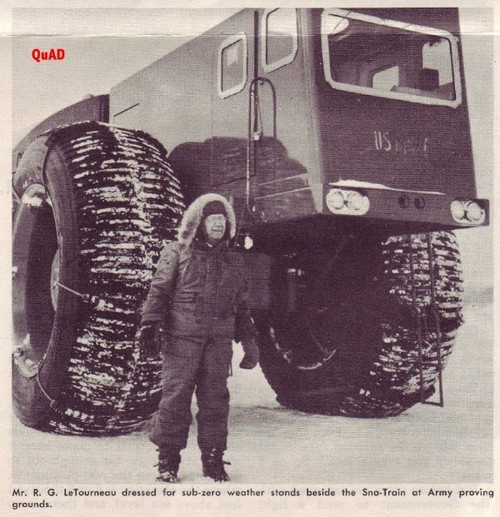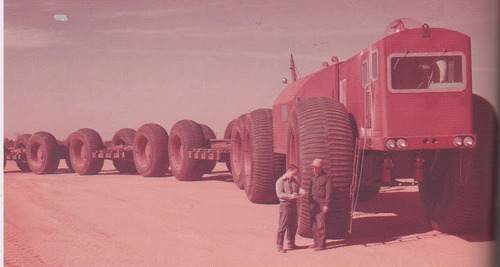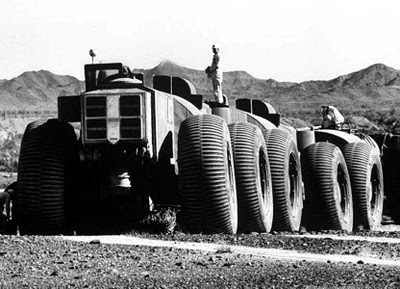
The Army Transportation Corps was impressed enough with R.G. LeTourneau's Sno-Freighter (see previous post) to order an upgrade. The result was the Logistics Cargo Carrier, or LCC-1, fondly referred to as the Sno-Train (shown above with Letourneau standing in front).
The Sno-Train's control cab was split into two articulated compartments: the front compartment contained drive controls and bunks for her crew while a rear section contained her 600 hp diesel engine, generators, and fuel tanks necessary to propel the behemoth. Her diesel engine delivered electricity to each one of her 16 individually powered wheels, and since the train was designed to run 24 hours a day, her three man crew slept in shifts.

The Sno-Train (shown above) was an improvement over the Sno-Freighter in that she was lighter with a lower center of gravity. Although her three cargo trailers only carried 45 tons, her 10-foot high wheels distributed her weight more evenly than her predecessors which helped prevent her from getting bogged down in the Alaskan tundra (frozen or otherwise).
LeTourneau delivered his Sno-Train to the Army in March 1956. After a thorough testing period she was deployed to Greenland eventually ending up in Alaska where she supplied the DEW radar line her progenitor helped build.
One report claims the Sno-Train tried to rescue her derelict older brother which had been abandoned in a snow drift after an engine compartment fire. But as appropriate as this seems, the story is unconfirmed.
LeTourneau's Sno-Train had a longer, more productive career than her siblings, operating in Alaska until 1961. To see a short video of the Sno-Train in action, click here.
The Sno-Train may have been a good start, but the Army wanted their land trains to carry a larger payload. The answer was the Overland Train Mark II which, at 565 feet in length, is the longest off road vehicle ever built (photo below courtesy of Life magazine).

Constructed at a cost of $3.7 million, LeTourneau's land train had a six-wheeled locomotive cab; 10 cargo trailers; and two power-generating cars. Her gas turbine engine weighed considerably less (and generated more power) than the Sno-Train's diesel engine. As a result, she carried up to 150 tons of cargo equal to the capacity of 60 2.5-ton trucks. This was four times the Sno-Train's capacity, and she carried this load at a speed of up to 20 miles per hour.
Because the Overland Train's engine took up less space than the Sno-Train's, her 30-foot tall command car was far roomier. As a result, she had sleeping quarters, toilets and a galley for six men. When she needed to have her 400-mile range extended additional fuel trailers could be added at any point along her "train." She even had an on board radar.

Interestingly, LeTourneau's Overland Train (shown above) was an early hybrid. Her 3,500 hp gas turbine engine generated direct current which drove individual traction motors fitted to each one of her 54 WHEELS via reduction gears. Additionally, her innovative steering system allowed her to turn corners far more sharply than the Sno-Freighter. In fact, she was so robust she could ford terrain as harsh as the Sahara dunes or an Alaskan snow drift.
LeTourneau shipped his land train to the Army's proving ground in Yuma, Ariz., in February 1962. Unfortunately, heavy-lift helicopters ensured his invention was obsolete before she could be deployed. Though testing went well, the Army canceled the project shortly after the Overland Train's arrival. But that didn't put an end to LeTourneau's efforts, for he was not a man easily deterred.
TO BE CONTINUED...